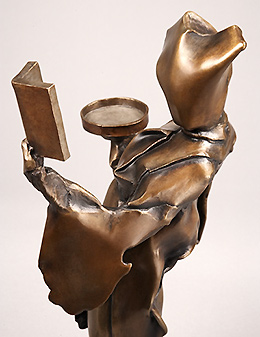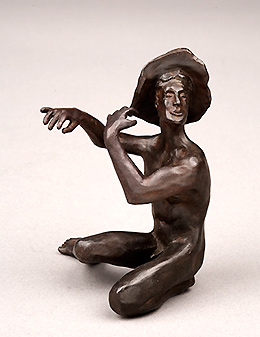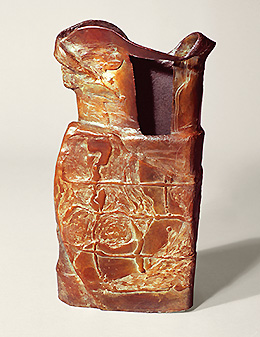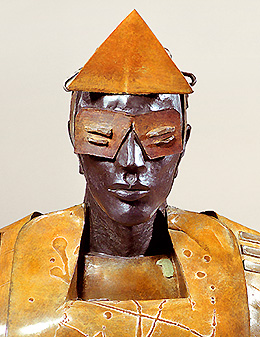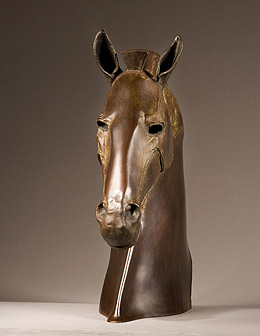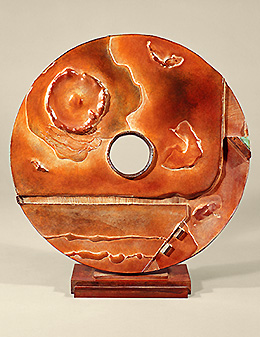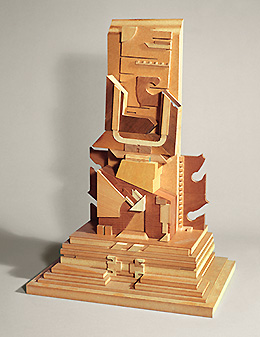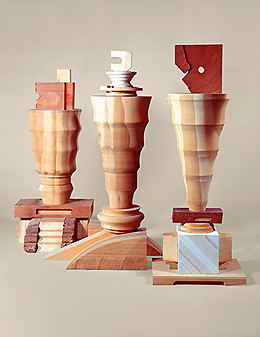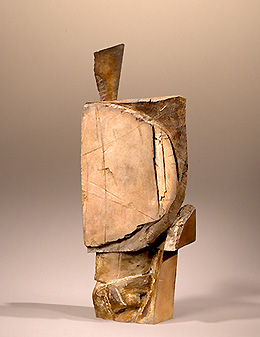|
|
|
|
|
|
|
|
|
|
|||||
|
|
|||||||||||||
The Medium is the Message
|
|
||||||||||||
Anderson regards his HORSEHEAD, 1978 as his first mature piece. (see HORSES AND WILDLIFE GALLERY) Unlike the classically inspired figures he had been modeling in wax, this piece was constructed from wax sheets. Anderson has never lost his childhood passion for architecture. He loved to construct buildings from any materials at hand, whether balsa wood or the mud from the bluff behind his grade school. Sculptors either carve, model or construct. Anderson frequently combines them all. His first real style, however, he calls thoroughly 'construction-oriented' and was based on his manipulation of wax sheets. He says he cut patterns like a tailor and instead of needles he used toothpicks to piece the sections together. Wax is a hardy material if kept cool. It was two years before Anderson cast his horsehead at Nordhammer Art Foundry in Oakland. The owner Rolf Kriken cast in the traditional 'investment' manner, which means the wax with sprues is potted in a vat of plaster. The wax is then melted out, hence the term 'lost wax process' and the bronze is poured in. Anderson at that time participated in the 'break-out' from the plaster and learned how to finish the raw bronze surface with the appropriate tools. Some sculptors bring their originals to the foundry and then let the foundry handle all the steps from mold to patina. Anderson, however, has been a 'hands on' sculptor, in the sense that he remains immediately involved with the many steps, in particular the dressing of the waxes and the finishing of the metal. |
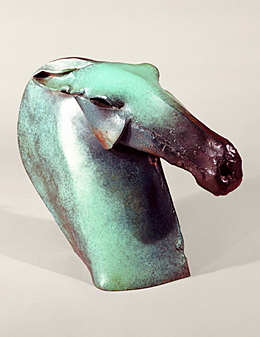 HORSEHEAD, 1978 bronze |
||||||||||||
|
A casting note: do not confuse the artist's wax original with the hollow wax that is actually cast. An artist's originals can be made from such materials as wax, clay, wood or plaster. However what is cast is a hollow wax that is made from slushing wax in a rubber mold. Occasionally wax originals can be cast if they are hollow and thin enough. Some of Anderson's earliest vessels were cast this way and are consequently unique. (see IMAGINARY DIGS GALLERY) In 1986 Anderson, at the suggestion of Peter Voulkos, began casting with Piero Mussi at Artworks Foundry on Heinz Street in Berkeley. At that time ceramic shell casting was new, but its thin dipped shell and subsequent integrity of detail were persuasive. By 1986 Anderson's working technique in wax had also evolved to a real mix of construction and modeling. His figurative work from this period is on the one hand, very stylized, yet in the way they talk among themselves the figures create a mythological world that is both personal and archetypal. (see INNER SANCTUM GALLERY) |
|
||||||||||||
|
CALIFORNIA ZEN MASTER, 1980 is a dramatic example of Anderson's ability to blend the past with the immediacy of the contemporary. The shape recalls both the Momoyama busts of Japanese Zen Masters as well as the portrait reliquaries of saints from the European Renaissance. The triangular cap is a modern nod to 'pyramid power' which like magic crystals was a 'healing power' fad of the early 1980's. The splashes of decorative relief on the vestments are also a nod to 'abstract-expressionism'. The goggles, of course, are a nonsensical nod to California's craze for sun glasses of any sort. Anderson says "I don't live in a vacuum. I rove all over art history and find shapes and subjects that still resonate. I merely reinterpret them in light of both my times and my own personal circumstances." |
|
||||||||||||
Anderson's slender and enigmatic portrait of MERITATEN, 1981, the eldest daughter of Nefertiti, clearly demonstrates the sculptor's mix of modeling and construction. The head and neck, especially the lips and eyes, have been delicately rendered in wax, while her simple gown is a real wrap, in the sense that a sheet of wax has been wrapped around her adolescent torso. William Smith, the assistant director of the Philadelphia Orchestra, had not only a love of music, but a love of language, including the poetry of names. During a holiday dinner discussion with the artist about the names of famous horses they were both stumped by the name of Alexander the Great's horse. When they finally remembered it, Anderson felt compelled that at their next holiday dinner he would present Smith with the head of BUCEPHALUS, 1983. (see HORSES AND WILDLIFE GALLERY) Like Anderson's other horsehead it too is constructed from wax sheets. Even the ears have been cut and folded from wax sheets. Yet these ears, by the way they're cocked and poised, give the horse that inimitable sense that it's been groomed to listen to only you. The warrior with a helmet, called HANNIBAL, 1981, and the bust of THE POET, 1981, hold their own so to speak, but as a pair they're a visual response to that classic theme of the dichotomy between the 'active' life' and the 'contemplative' life. Anderson's sensibilities on the whole have a balanced regard for decorative elegance enriched by `ntellectual discourse. (see INNER SANCTUM GALLERY) |
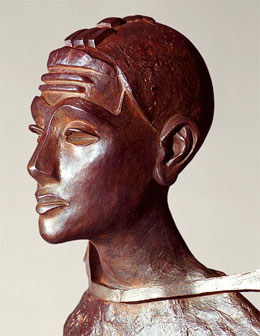 MERITATEN, 1980 bronze |
||||||||||||
Landscape is generally considered to be a genre favored by painters or photographers, however, Anderson is one of those rare sculptors who tackles landscape as a serious vehicle for 'three dimensions'. In the 1980's Anderson created a series of topographical discs called METAPHYSICAL LANDSCAPES. "They are metaphysical in the sense that they are at once archetypal as well as imaginary landscapes, rather than a mere document of a specific landscape in the here and now," he explains. These discs once again show Anderson's reverence for historical antecedents. In this case, Shang and Han jade discs, with their center holes, act as prototypes. The shape is called the 'bi' and is the symbol of heaven. "I consider it heavenly and certainly a heavenly perspective when I'm looking out the porthole of an airplane flying from San Francisco over the American West to such destinations as New York, Boston, Minneapolis or Miami. These discs commemorate my aerial experiece of landscape, and hopefully will encourage others to book the window-seat," Anderson adds. (see METAPHYSYCAL LANDSCAPES GALLERY) |
|
||||||||||||
In the 1990's Anderson continued his exploration of construction as a technique, except now he moved from wax to wood. While wood is usually its own medium, Anderson insists that in his case the wood is just the model stage before molding it for casting in bronze. Anderson's first series in wood is called TEMPLES AND TOWERS. The very first models were constructed in 1989 and all but two were destroyed in the Prieto Loma earthquake of October, 1989. The temple called TAMALPAIS, 1989 is a bronze cast of one of the two wood models to survive. Others such as the OWL TEMPLE, 1989 and the THUNDERBIRD SHRINE, 1989 were either reconstructed or made from pieces thrown against the wall or onto the floor. Miniature buildings such as miniature stupas have been used in the past as shrines to commemorate the dead. Anderson's temples also act as shrines to honor the many dead from either plague, illness, war or disaster. TEMBLOR, 1989, which is an anthropomorphic representation of the earthquake, was started that very October amid the debris and destruction. The artist's Oakland studio at West Grand and Adeline was only three blocks from where the double-decker freeway collapsed. More disaster. ZOROASTER, 1992 is a response to the Oakland Hills fire which destroyed three thousand homes. Anderson vividly remembers the day. "At first I was at home. That's when I saw this huge black cloud of smoke across the bay and rushed over to my Oakland Studio. I rolled my big doors up and I nervously watched the heavy ash fall from the sky to the street. Chunks of burnt wood and charred pages from books were just drifting down. I was fearful that the roof to our building might catch on fire. I was prepared to carry out whatever I could salvage and just pile it on the street. Fortunately the fire never reached our neighborhood." (see TEMPLES AND TOWERS GALLERY) Anderson in the 1990's continued his exploration of architectural construction with a second series of wall altars, which he calls RETABLOS. In the American Southwest a retablo refers to a wood or tin panel decorated by a santero, a painter of saints. Historically, and more accurately, a retablo is three dimensional and structural. It is the framework, often behind the main altar of a church, which holds either painted panels or given ledges sculpture or ephemeral offerings such as candles and flowers. Anderson's retablos aspire to more universal claims of devotion. He prefers to regard them as windows on the soul. Whatever your spiritual inclinations they can act as personal sanctuaries whose ledges and sills are open to hold some object of hope and gratitude such as a feather, a rock, a shell, a flower, a heart-shaped leaf, or perhaps a photo. Anderson's retablos are meant to serve as well as encourage the imagination and the spirit of anyone who collects one for their wall. (see RETABLOS GALLERY) |
|
||||||||||||
Anderson's third series of the 1990's is called the THREE MAGI. The wood models, each named after one of the Magi, are three tall urns. The urns may suggest a figure or torso, but they're really meant to evoke vessels to hold the precious gifts of frankincense, incense and myrrh carried by the Magi. (see THREE MAGI GALLERY) Anderson says he always likes to ask artists or collectors, "What is the very first artwork that got your juices going?" He says for him. "It's the Jade Mountain now at the Minneapolis Institute of Arts. As a boy I was just mesmerized by that carving. It was a little world unto itself. Ever since then I've always wanted to make my own mountains." Anderson adds, "Since then I've also learned about Chinese Scholar Stones. Unlike the Jade Mountain, those stones are not carved, but are found objects, and revered for their reference to the tortured shapes of China's mountains. If you don't have a mountain outside your window, the scholar stone acts as a spiritual substitute for contemplation. With those thoughts in mind I have now tackled mountain building." |
|
||||||||||||
|
In the summer of 2003 Anderson started his series of mountains. He says they can be considered elemental rock-pilings in bronze or they can refer to the simple pilings of rocks made by hikers to mark a trail. Anderson notes that his series of TRAIL MARKERS reflects the American mountains he knows and loves. He says, "It starts with the high bluffs of the Mississippi River, which may not be mountains, but they're an impressive crop of rocks. Next comes a childhood visit to the Garden of the Gods just outside of Colorado Springs. It's a haunted place. I've never lost my awe for those precarious balancing acts of geology." Much of the magic of bronze stems from its volcanic origins. The crucible with its orange combinations of molten metals is something of a microcosm of the earth's interior. Anderson's Trail Markers both literally and figuratively put him in touch with the primal flow. (see TRAIL MARKERS GALLERY) |
|
|
|||||||||||
A NOTE ABOUT PATINAS: Left on its own outdoors bronze turns brown and then shades of green. Consequently the studio patina that is laid on a bronze, like beauty, is only skin deep, and because of its delicate nature it should be respected and handled with care. Roger Arvid Anderson has been working with patina master Karl Reichley since 1996. The remarkable patinas featured on this website happened because Karl Reichley shared his expert skills with the artist's vision. It should also be noted that many of the casts before 1996 have been repatinated by Karl Reichley in light of his great magic and talent with color, the brush and the torch. |
|||||||||||||
